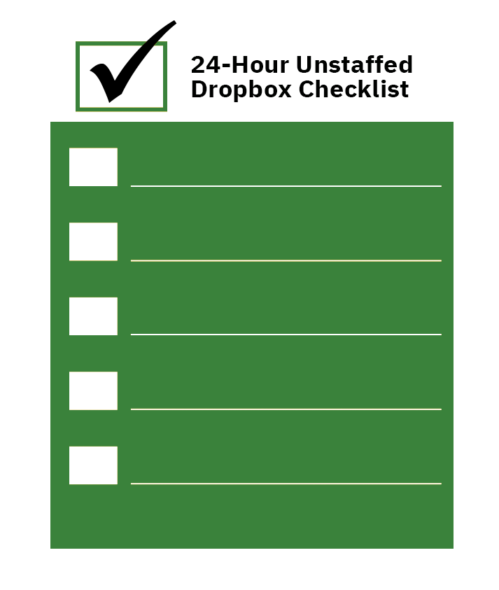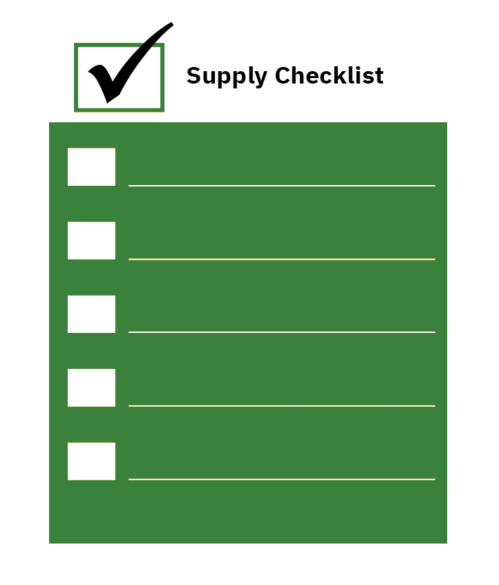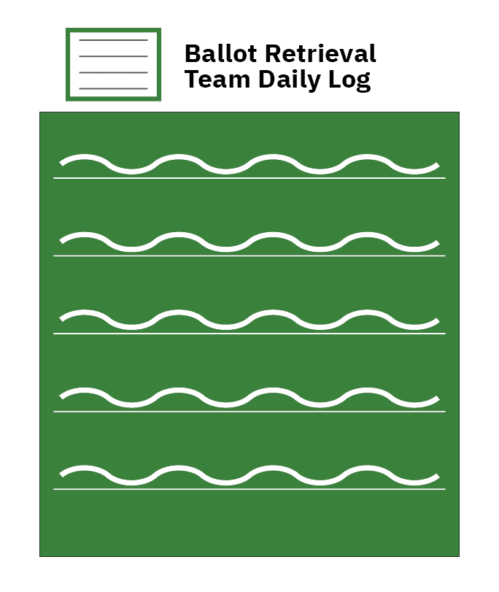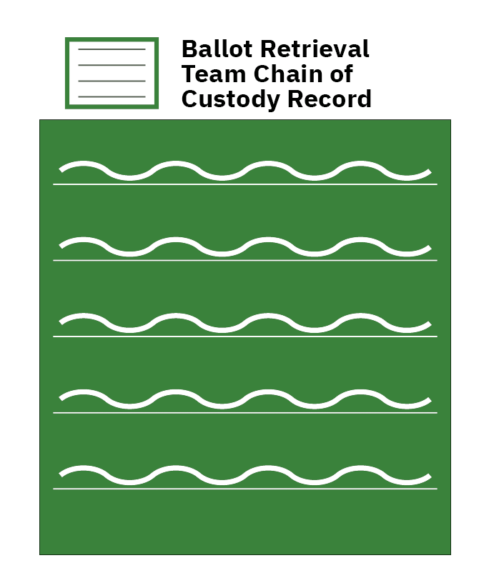January 21, 2022
Ballot Drop Box Implementation
Download our guide:
Ballot drop boxes offer a secure, convenient alternative for voters to cast their completed mail ballots. They save money for voters in jurisdictions where return postage is not prepaid, and they can reduce costs for election authorities where postage is paid.
Understanding the Guide
Voters like ballot drop boxes. In jurisdictions where vote-by-mail is prevalent, as many as 80 percent of voters choose to return their ballot at a ballot drop box.
A ballot drop box program can help build public trust in the election process. Ballot drop boxes can reassure voters who mistrust the postal system because of lost or delayed mail, or who worry about someone potentially tampering with their ballot. Ballot drop boxes also provide a solution for voters who are concerned about their signature being exposed to anyone outside of their local election office.
For election officials, ballot drop boxes ensure ballots are received in time to be processed. This is critical since many voters wait until Election Day to return their ballots.
This guide is divided into three sections:
-
Planning will help election officials decide the type, location, equipment and staffing for three types of ballot drop boxes.
-
Voter Outreach and Communication contains suggestions for promoting ballot drop box convenience and availability, and to publicize your request and return deadlines.
-
Execution includes sample forms that can be used separate from this guide to train temporary staff and used as a daily checklists and chain of custody logs, including a section for Election Night.
Using the Guide
Table of Contents
Planning
How Many Ballot Drop Boxes Do I Need?
Estimating an adequate number of ballot drop boxes can be challenging when you don’t know how many voters will use them. And determining how many to obtain will be constrained by your budget, purchasing process, and ability to deploy multiple boxes before Election Day.
Hiring enough temporary workers to staff ballot security teams is another critical factor. To maintain public trust you should have bipartisan, two-person teams picking up ballots from each drop box on a daily basis. You will need more frequent pick-ups in the days leading up to and including Election Day. Early on, some busy locations may also require frequent pick-ups, perhaps multiple times a day.
A rule of thumb to consider is one drop box for every 10,000-15,000 voters; that is a common requirement in states where mail ballots are the primary voting method. Your geography should also inform how many drop boxes to place. For example, rural, sparsely populated areas may require more drop boxes per capita than densely populated urban areas.
Scaling Up
Ballot drop boxes should be available to voters as soon as ballots are mailed and remain available through the close of polls on Election Day (or as the statute in your state provides). Unstaffed drop boxes are usually available 24 hours per day. Staffed drop boxes or drive-up options are typically offered on a more limited schedule, such as during business hours and full polling hours on Election Day.
If adequate staffing is a problem, consider starting with fewer drop boxes and scaling up to the full number you need closer to Election Day. Note that scaling up over time presents P.R. challenges. You will need to clearly publicize drop box locations, plus the dates and times that each location is available.
Where Do I Place Them?
To choose ballot drop box locations, election officials should consider these factors at a minimum:
-
Concentrations of population
-
Concentrations of historically higher mail-voting populations
-
Geographic distance and features
-
Voter convenience
-
Proximity to public transportation
-
Community-based locations
-
Security, including lighting, visibility, and security cameras
-
Ensure that ballot boxes are accessible to voters with disabilities. Refer to and follow ADA requirements for polling locations. A generic checklist for ADA considerations is available as well: ADA Checklist
The Center for Tech and Civic Life (CTCL) created a Ballot Drop-off Location Criteria Planner to help jurisdictions evaluate potential ballot drop-off locations.
Purchasing Considerations
The type of ballot drop box(es) you use will depend on your plan and budget. Drop boxes come in several sizes, types, and different construction materials to withstand vandalism and inclement weather and to prevent removal. The following section will cover three types of ballot boxes: a 24-hour permanent box, a temporary indoor box and a temporary drive-through ballot drop-off.
24-Hour Unstaffed Ballot Drop Box
A 24-hour ballot drop box mimics a USPS blue mailbox. It is a permanent metal structure accessible by vehicle or on foot in the public right-of-way, and should be well-secured to the ground. Styles vary. These can be installed on your jurisdiction’s property, or you can arrange to install one at a partnering public agency (see list in previous section.) This usually means securing a written agreement with property owners to locate and secure these drop boxes on their property before you purchase them. A list of drop box vendors is located in Appendix A.
Temporary Indoor Ballot Drop Boxes
Temporary indoor ballot drop boxes or bags are portable and much smaller than 24-hour drop boxes. Smaller options have handles on the side for carrying and are small enough to rest on a table. Larger options can hold more ballots and are on wheels. Bipartisan teams of two election workers usually monitor these drop boxes or bags.
Ideally, these drop boxes or bags should be available inside every polling place, to offer voters the greatest convenience for dropping off mail ballots. Ballot drop boxes placed inside the polling location may be serviced and staffed by poll workers rather than separate ballot collection teams.
They can also be located inside government buildings, libraries, community centers, and other high traffic areas. Your agency could secure an agreement to have staff from these partnering agencies monitor the drop box during their business hour and during polling hours on Election Day. The agreement should ensure access for your ballot retrieval team to pick up the ballot drop box or bag at scheduled times.
Temporary Drive-Through Ballot Drop Box
A drive-through ballot drop box is staffed by bipartisan teams of two election workers on a street or in a parking lot. These workers safely approach a vehicle, accept the voted ballot envelope from the voter, and deposit it into a ballot drop box while the voter observes. At minimum, these workers are equipped with safety vests and badges, a canopy tent for shelter, a table and chairs and locked ballot boxes. This option is usually only deployed on the last few days of the election, including Election Day.
Drive-through locations can be very convenient for voters as they do not need to park or exit their vehicles. They also offer greater operational efficiency for election administrators because they can absorb some of the traffic from high-demand, 24-hour ballot drop boxes on Election Day.

24-Hour Unstaffed Dropbox Checklist

Temporary (Indoor or Outdoor) Dropbox Checklist
How Do We Secure Drop Boxes?
Locking Requirements
All drop boxes shall be secured by a lock and a tamper-evident seal. Only an election official and a designated ballot retriever shall have access to the keys and/or combination of the lock. If your drop box(es) are secured by a key lock, be sure to make copies of each key and store them securely at your election facility.
Video Requirements
If feasible, both temporary and 24-hour drop boxes should be monitored by a video security surveillance system, or an internal camera that can capture digital images and/or video.
A video security surveillance system is especially critical for unstaffed, 24-hour boxes and can include existing systems on county, city, or private buildings. The video system should be robust enough to capture and store video for the full time the ballot drop box(es) are open to receive ballots during an election. These videos may be considered an election record, and thus may need to be retained for a certain period of time after each election, depending on your state laws.
The easiest way to provide video surveillance is to position your ballot drop box within view of an existing video surveillance system. If you need to install your own system, work with your city/county IT, facilities, or law enforcement division to see if there are similar systems used throughout the city/county. Chances are your jurisdiction already has a vendor set up for this type of equipment.
Bipartisan Election Workers (Drive-Through Locations)
Drive-through ballot drop boxes must be monitored very closely by election workers to ensure that someone does not drive-off with a ballot drop box.
Other Safety and Security Measures
Unstaffed drop boxes placed outdoors should be securely fastened to prevent moving or tampering. For example, fasten the drop box to concrete or an immovable object. This will prevent unauthorized removal of the drop box.
Staffed drop boxes have several options, but all options should take into consideration additional security measures when the ballot drop site is not staffed. Safeguarding the drop box during unstaffed hours could mean the drop box is inaccessible to the public when not in use. The box should be secured in a locked room, sealed with a tamper-evident seal, and if possible, under video surveillance. Staffed drop boxes should be securely fastened to a stationary surface or to an immovable object, and/or placed behind a counter, and/or portable so they can be transported to a curbside area or a mobile voting area. When in use, these drop boxes should be constantly monitored by election officials or other designated representatives.
Work with law enforcement to include frequent patrols of unstaffed drop boxes. In some communities, it might also be appropriate to develop a network of citizens willing to regularly patrol unstaffed drop boxes.
Work with the public works department and law enforcement to make drive through locations safe and secure.
Ballot Retrieval
Once the locations of your ballot drop boxes are set, you should begin planning daily routes for ballot retrieval. This includes sending teams to visit all ballot drop boxes – permanent and temporary. The frequency of pickups may vary in the beginning, every other day versus every day, and become more frequent – multiple times per day – the closer you get to Election Day.
The time it takes to retrieve ballots will depend on the type of ballot drop box used. Ballot retrieval teams will be able to park close to most permanent, 24-hour drop boxes. They will need to transfer the contents of the drop boxes to portable bags or boxes, seal the boxes, complete their chain of custody paperwork, and load the portable boxes into a vehicle.
Temporary, staffed ballot drop boxes are usually located inside a building. This means ballot retrieval teams will need to park and walk into the building to the room where the temporary ballot drop box is located. Most often, they will switch out the full ballot drop box for an empty drop box, complete the chain of custody paperwork, and carry the full drop box or bag back to their vehicle. The process for temporary drive-through locations will be similar.
Driving Routes
The process of retrieving ballots will be most efficient if retrieval teams are able to follow pre-planned driving routes. This can be made easier with mapping technology. Some election offices use commercial software such as Routific and Esri Workforce. Google Maps is a free option that most staff will be familiar with and find easy to use.
When using Google Maps, begin by mapping out a route that you think can be completed in four hours. Identify each location, including the starting and ending location (typically the election office). Assume that the necessary steps at each location will take approximately 15 minutes to complete. Adjust the number of drop boxes on the route until you are able to achieve a route that can be completed in roughly four hours. Be sure to map it during the same times your retrieval team members will be on the road to account for daily traffic patterns. Also consider adding in break times as needed for your retrieval teams.
Consider using mobile phone tracking applications or GPS spot trackers as a way to ensure the assigned route is followed without deviation and that your retrieval team is on time. This may also help document your chain of custody.
Frequency of Retrieval
The frequency with which you retrieve ballots from each ballot drop box depends on multiple factors, including:
- Timing (How close to Election Day is it?)
- Projected and actual voter turnout
- The number of ballot boxes you have
- How many ballots each box can hold
- The geography of your jurisdiction and distance retrieval teams have to travel
Generally, it is important to retrieve ballots at least once per day from the first day ballots may be returned. This will ensure ballot security and the ballots can enter your processing operation as quickly as possible. From there, structure your retrieval plan around a slowly building stream of ballots. Jurisdictions have seen as few as 20% of ballots cast by mail deposited in drop boxes during the first two weeks and as many as 55%–60% of ballots deposited during the last two days of the election, including 40% of ballots cast on Election Day. You will need to retrieve ballots multiple times per day from your busier ballot drop boxes the closer you get to and on Election Day.
Other Important Considerations
Your plan needs to be flexible. If voter turnout is higher than anticipated, you may need to retrieve ballots multiple times per day sooner than you had planned to scale up.
- On the Monday evening before Election Day, you must retrieve ballots from all drop boxes at the end of the day so they do not fill overnight and to maximize the number of ballots you can count on Election Day.
- On Election Night, you must close all drop boxes simultaneously with closing the polls. This will take significant staffing and coordination.
- It is important to track as much data about this process as possible. Retain it for future planning, including how many ballots you retrieve from each drop box each day and how many retrieval runs were needed to each drop box each day. This data can be obtained from ballot logs and reviewed after the election.
Staffing Needs
Use the mapped driving routes and frequency of retrieval to determine how many teams and vehicles you will need and for how long. For example, in the first few weeks after ballots are mailed out you might only need three teams of two (six temporary workers) and three vehicles. That number might increase significantly or even double as you start the week leading up to Election Day.
The biggest staffing challenge for ballot retrieval will be at the close of polls on Election Night. You will need bipartisan teams to close and seal each ballot drop box right at the close of polls (or as the statute in your state provides). Many jurisdictions recruit staff from sister agencies, since drop box closing teams do not require full poll worker training. Remember, these ballot retrieval teams will need to be bipartisan, even those staff recruited from other agencies, and may need to be sworn in as election workers.
As mentioned in the overview, accommodations for COVID-19 and the need for social distancing will affect your staffing decisions. Asking two unrelated workers to drive together in the same car may be a challenge. You will need to accommodate any retrieval team member requests to travel in separate cars in tandem. The steps for setup and the daily retrieval of ballots should also follow the six-foot distancing requirements.
Voter Outreach and Communications
Use your regular print and electronic materials, website, social media, video, and news releases to announce ballot drop box locations and share a link to a comprehensive list and/or map of ballot drop boxes.
You can also include a list of ballot drop-off locations in your mail ballot instructions, voter information guide and sample ballot publications.
Create a web page for Ballot Drop-Off Locations. Include a list of all location names, addresses, hours and embed a link to a Google map for each. Another creative idea is to develop a ‘Find My Nearest’ web-based tool to help voters find the ballot drop box that is closest to them.
You can also create and embed a map of all ballot box locations using Google My Maps.
Issue a news release and photos if you have installed one or more new 24-hour ballot drop boxes in your community. Share it with your own employee news channels, local news media, submit a contributed article for a community newsletter, blog or website regarding the election as well as jurisdictions for newsletters and public television news shows.
Execution
Opening and Setup
Whether you are setting up a temporary ballot drop box or a 24-hour location, you will need to plan for a ballot retrieval team to set up, open, and secure the drop boxes for voters to deposit their voted ballots.


Daily Collection of Ballot Drop Boxes
-
Only designated bipartisan ballot retrieval teams should remove ballots from drop boxes. This is done in teams of two.
-
All designated ballot retrieval team members should wear badges or vests that readily identify them as designated ballot retrievers or election officials.
-
Each team of two will be provided a route each day. Ballots must be picked up in a designated order.
Staff should be trained on checking inventory against the supply list, completing the retrieval team daily log, and completing the ballot retrieval chain of custody record.

Ballot Retrieval Team Daily Log

Ballot Retrieval Team Chain of Custody Log
Election Night Closing
All ballot drop boxes, temporary and permanent, need to be collected or closed at the time the polls close. The process outlined below is focused on permanent, 24-hour drop boxes, but the same general principles can be applied to temporary ballot drop boxes. These instructions can be supplemented with the Election Night Closing Checklist that follows.
Station a bipartisan retrieval team at each drop box 15 minutes before the polls close. They will lock drop boxes as soon as the polls close and retrieve ballots.
-
Consider asking other jurisdictions’ employees to assist, since this process does not require a great deal of training. Provide each retrieval team with the necessary supplies and checklist as detailed in this guide.
-
You may have a line of people, or cars, at close of polls with people waiting to cast their ballot in the drop box. As with in-person voting, have one person walk to the end of the line of people and/or cars and hand the last voter in line at close of polls the “Last Voter In Line” card to ensure everyone in line at close of polls may cast their ballot.
-
Instructions for how to handle a line of cars (if 24-hour drop box or drive-through ballot drop-off) or a line of people (if temporary indoor drop box). This should include a “Last Voter in Line” card and potentially coordinating with local law enforcement for traffic control.
-
Recommend teams take pictures of:
-
Locked ballot slot
-
Inside of the 24-hour boxes once emptied after the close of polls to show that no ballots are left in the box.
-
It is highly recommended to have your daily ballot retrieval team visit all ballot drop boxes the day after the election to double-check that all ballots were collected.




